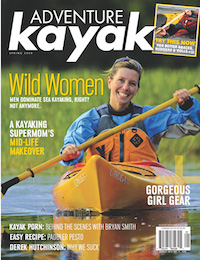Iwant you to finish reading this article and leave immediately for a wilderness trip. My happiness depends on it, not to mention yours. I just told a friend about my plans for a two-week kayak trip this spring. He said, “Wow, that’s old school!” I never thought of myself as old school, but now maybe I’ll bring some itchy wool pants and pemmican on the trip.
The reality is that we spend less and less time in the wilds each year. My two-week trip is old school. The Outdoor Recreation Participation Study lays out the evidence in clinical fashion. In the past 15 years, the average length of a wilderness outing has gone from six days to three hours. The average North American camps away from their car just once a year. Backpacking is an endangered species, freefalling by 22 per cent in seven years. Look at gear—it’s for fast and light. Field guides are for short day trips. Our “wilderness experience” is now something we cram into half a day between working in the yard in the morning and a movie that night.
USING WIFI IN WILDERNESS AREAS
Some parks are now less about the wilds than the wi-fi. Seventeen parks in Canada have installed wi-fi networks. So have the California and Texas state parks systems. Oregon is considering it. See a bird you don’t know on your morning paddle? Just whip out your BlackBerry and Google it. Shouldn’t we be surfing waves instead of the web? What happened to all those nights under the stars and cooking pancakes with our pals?
Reasons for spending less time in the wilderness abound, but I know one. We’re busier. And, lest I sound like an out- of-touch curmudgeon, I’ll admit I’m busier too. I’m writing this article on a sunny weekend when I should be outside. We’re working more, and we have kids’ soccer games, lawns to mow, and friends to visit.
Kayakers still care deeply about wilderness. We have often-recited tales of past trips, and formative memories of playing around off the grid as kids. While we juggle weekend to-do lists, we’re still dreaming of the long trips we may take someday. But there are signs of trouble. Just look at the local parks and forests near you. To agencies that manage the wilds, kayakers are just a “user group” on equal footing with jet-skiers, snowboarders and mushroom collectors. If we spend three hours paddling, they manage the wilderness for short half-day trips and neglect the backcountry, no matter how much we value it in our hearts.
LESS WILDLIFE HABITAT, MORE PARKING LOTS
Mount Hood, my local back 40, is a perfect example. There’s heavy use of a few day-hike destinations, while trails into the backcountry are being left uncared for. Campsites are left to decay or are closed entirely. The Forest Service pays less attention to wilderness ecology and wildlife habitat, and more to parking spaces at a few popular trailheads.
And sometimes we do forget about the wilderness. Last year Oregon had the first serious wilderness protection proposal in a decade, and few noticed. Thirteen years ago, the last time a wilderness bill popped up—when we spent 22 per cent more time in the backcountry—there was a big stir, complete with a rally that filled downtown Portland and brought Bonnie Raitt and Neil Young to town.
If we don’t have time to vote with our feet, we can still keep that wilderness fire alive. When you’re not paddling—or when you’re logged onto wi-fi at your favourite park—let the agencies know that wild places are still important. The agencies measure what we do, not what we dream about—until they start getting lots of e-mails about it. Then they listen.
And remember that your sea kayak is perfectly designed to carry you and yours into the wilds. On the weekends when you can’t swing a trip to the wilds, go camping locally. Paddle a few miles out to your favourite local spot for the regular, two- day weekend. Instead of chauffeuring the kids to soccer, bring them with you, and the soccer ball. Sleep out under the stars, mess around on some nearby island, roast marshmallows. Eat blackberries, but don’t try to get online with one. The pemmican is up to you.
Neil Schulman is an Oregon–based paddler dreaming about a trip in the desert, and another one somewhere up in B.C.




